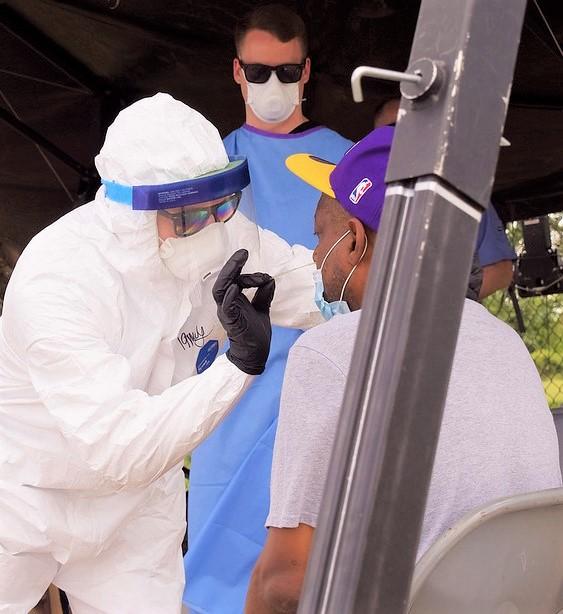Of four new studies of racial COVID-19 health disparities, all but one suggest that non-white, socioeconomically disadvantaged, and non–English-speaking populations shoulder disproportionate COVID-19 burdens.
Black, low-income patients
The first study, published today in JAMA Network Open, involved 2,595 patients tested for COVID-19 at a Milwaukee hospital from Mar 12 to 31. Of the 369 patients (59.1%) who tested positive, 218 (59.1%) were black. Black patients were 5.4 times more likely than those of other races to test positive. Other risk factors included male sex (1.5 times more likely than women to test positive) and being older than 60 years (2.0 times more likely).
Patient ZIP code explained 79% of the overall variance in positive coronavirus test results. After adjusting for ZIP code, black patients were 1.9 times more likely than whites to require hospitalization, while those living in poverty were 3.8 times more likely.
Poor patients had a 3.6 times higher odds of requiring intensive care, whereas black patients were not at increased risk. Black and poor patients were not more likely than their peers to require mechanical ventilation; rather, respiratory distress was tied to a history of smoking and high body mass index (BMI).
Twenty of 369 patients (5.4%) died of their infections (17.2% of the 116 who were hospitalized). Increased likelihood of death was associated with shortness of breath at admission, high BMI, and age older than 60 but was not tied to race or socioeconomic status.
The authors said that the findings suggest that the worse outcomes and higher likelihood of dying from COVID-19 linked to black race resulted from a disproportionately high number of infections in the black population rather than lower survival rates after hospitalization. One reason for the relatively high number of infections in blacks, the researchers noted, could be attributed to less ability to practice physical distancing due to crowded housing and fewer work-from-home options.
The study findings are "potentially encouraging" because they suggest no inherent racial vulnerability to adverse coronavirus outcomes, the authors wrote. "Rather, the burden of this illness among African American individuals may be mitigated by reducing the rate of infection using a combination of established and novel public health methods," they said. "Racial disparities associated with COVID-19 should not be used to propagate myths related to racial biology."
Slightly improved survival rates
Another study, which was published today in the same journal but reached different conclusions, was an analysis of data from 5,902 COVID-19 patients at a medical center in the Bronx, New York City, from Mar 14 to Apr 15.
Of the 5,902 patients, 1,905 (32.3%) were Hispanic, 1,935 (32.8%) were black, 509 (8.6%) were white, and 171 (2.9%) were Asian. Coronavirus positivity rates were 65.3% in Hispanics, 68.5% in blacks, and 53.0% in whites.
About a third of Hispanic patients (34.3%) had more than two underlying medical conditions, as did 39.5% of black patients, versus 28.9% of white patients. A total of 1,942 patients (32.9%) had diabetes, while 2,641 (44.7%) had high blood pressure. Underlying diseases predisposing patients to death included morbid obesity (BMI > 35 kg/m2), cardiovascular disease, diabetes, dementia, and kidney disease.
After controlling for age, sex, income, and underlying diseases, Hispanics and blacks had slightly better survival rates than whites (hazard ratio, 0.77 for Hispanics, 0.69 for blacks). Of the 918 patients who died, 309 (16.2%) were Hispanic, 333 (17.2%) were black, 102 (20%) were white, and 29 (17%) were Asian.
The authors noted that black and Hispanic COVID-19 patients had similar outcomes as those of their white peers. "These findings may provide some reassurance that access to the services available in comprehensive health care environments may attenuate, if not eliminate, racial/ethnic differentials in COVID-19 mortality rates" they wrote.
Race—or racism?
In a commentary in the same journal, Rohan Khazanchi and Jasmine Marcelin, MD, of the University of Nebraska and Charlesnika Evans, PhD, MPH, of Northwestern University, argue that racism rather than race is behind COVID-19 racial health inequities.
"The elevated incidence of COVID-19 among Black and Hispanic communities, largely attributable to social and structural vulnerabilities, seems to drive the differences in mortality among Black, Hispanic, and White populations," they wrote. "In short, rather than validating long-debunked hypotheses about intrinsic biological susceptibilities among non-White racial groups, the evidence to date reaffirms that structural racism is a critical driving force behind COVID-19 disparities."
Khazanchi and colleagues called for interventions to address the interactions of clinical and structural risk conditions, including the spillover effects on the mental, physical, and financial health of blacks and Hispanics. "Clinicians, health systems, and policy makers alike must grapple with the fundamental inequities that lie upstream of disparate COVID-19 outcomes to make tangible progress toward health justice," they said.
Minority, low-income children
In the third study, published yesterday in Pediatrics, researchers at Children's National Hospital in Washington, DC, analyzed COVID-19 data from 1,000 patients referred to a pediatric drive-through and walk-up testing site from Mar 21 to Apr 28.
Of the 1,000 children tested, 20.7% were positive for COVID-19. Minority children had higher rates of infection than white children—46.4% in Hispanics, 30.0% for blacks, and 7.3% for whites—as did those from lower-income quartile 3 (23.7%) quartile 2 (27.1%), and quartile 1 (37.7%), versus 8.7% in the highest quartile.
After accounting for age, sex, and family income, minority children were 2.3 times more likely than white children to have a coronavirus infection. The difference increased over time in Hispanic patients but not in other racial groups.
Black children and those of other racial groups were also more likely than white children to report known coronavirus exposures (34.9% of blacks and 19.8% of other races, vs 11.3% of whites). And children from low-income households (29.3% in quartile 2) had higher rates of exposure to the virus than those from families in the highest income quartile (12.3%).
"Future work to ensure equitable allocation of testing and culturally appropriate prevention education may help improve early identification, quarantine, and distribution of resources to reduce community spread of disease," the authors wrote.
Testing disparities by language
The fourth study, detailed in a research letter published yesterday in JAMA Network Open, involved analysis of data from 30,925 patients who underwent COVID-19 testing in the University of Washington Medicine system in Seattle from Feb 29 to May 31.
Of the 30,925 patients, 1,869 (6%) were non-English speakers, who were less likely to have completed coronavirus testing than native English-speakers (4.7% vs 5.6%), although the proportion differed by language group.
Non-English speakers tested positive at 4.6 times the rate of English speakers (18.6% vs 4.0%), and this disparity persisted across multiple languages and in the three largest non–English-speaking groups (Amharic, Spanish, and Vietnamese).
The researchers noted that patients living in neighborhoods in which community-based testing strategies had been instituted were more likely than others to get tested. The health system had used mobile clinics and drive-up testing to overcome barriers to testing, which they recommend for areas with high infection rates and limited testing access.
"Until we routinely examine quality of care outcomes by granular demographic measures, such as language or country of origin, disparities in care for immigrants can continue to remain hidden," the authors said.





















